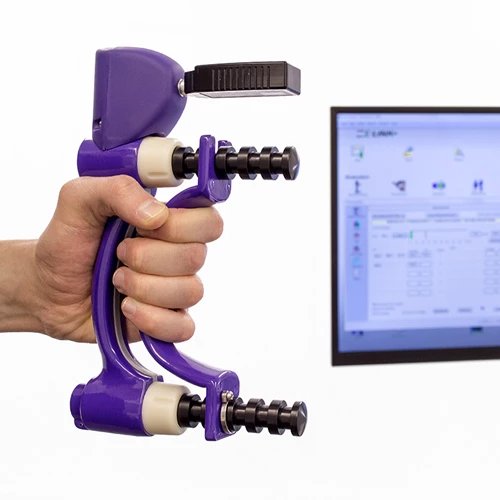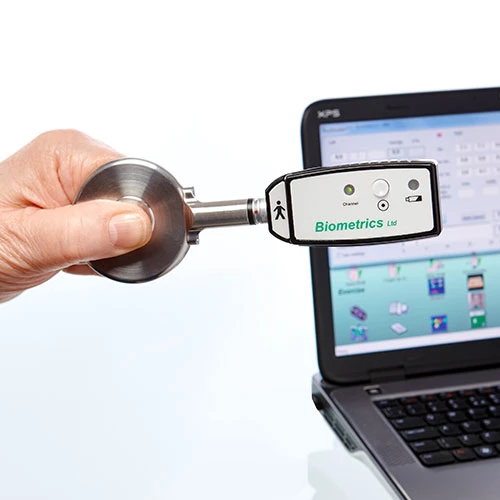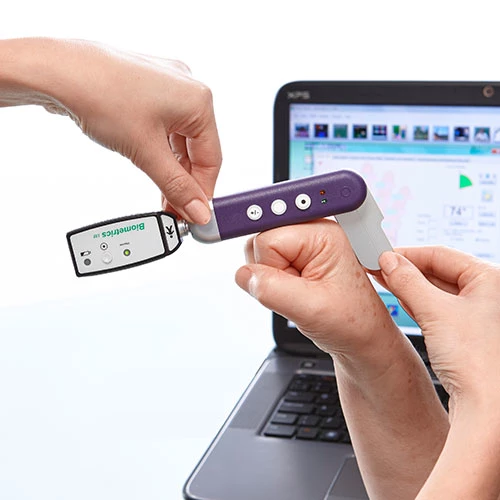Hand Therapy Evaluation
With E-LINK, formal evaluation of grip and pinch strength and joint range of motion can commence very early in hand therapy and continue throughout the full rehab process. E-LINK is invaluable in generating progress reports as definitive clinical outcome measures. Data can be readily exported for audit and research purposes.
E-LINK Dynamometer
The Hand Grip Dynamometer easily and accurately measures a patient's grip strength from 0.1kg/lb measurement through to a maximum of 90kg (200lbs), covering those with chronic debilitating conditions, such as rheumatoid arthritis, as well as those with acute hand injuries.
The following tests, using the Dynamometer with E-LINK software, can be carried out quickly and accurately and include assessments that cannot be undertaken with a manual device:
Standard Peak Force Grip Test (1/4)
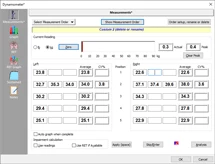
Three measurements can be quickly entered for each hand position as required. The software automatically calculates the average grip and the coefficient of variation percentage as an indication of the measurement consistency. A force distribution graph is displayed for the five positions.
Sustained Grip Test (2/4)

This test measures force over time for a 5, 10, 15 or 30 sec interval. Peak force, time to reach peak force, average to peak ratio percentage (sustainability) and fatigue rate are automatically calculated and immediately displayed. The current graph can be compared with a prior test to analyze progress.
Rapid Exchange Grip Test (3/4)
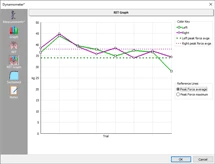
Undertaken for the detection of sub-maximal effort, this test is easily performed and documents the grip force applied for eight tests of each hand with a 1, 1.5 or 2 sec interval set timing. The results are displayed in both graph and table form for immediate analysis.
Progress Reports (4/4)
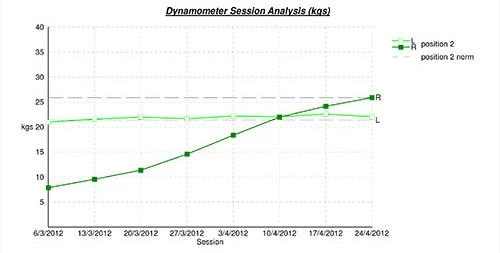
Progress Reports can be readily generated covering a maximum of 10 tests and the data is displayed in both graph and table format. Automatic calculations show the percentage of change from one session to another, the percentage of change from the first test and the percentage comparison to standard, normative Jamar data for both pediatric and adult values. Ideal as an Outcome Measure and for a Discharge Summary.
E-LINK Pinchmeter
The Pinchmeter easily and accurately measures a patient's pinch strength from 0.1kg/lb measurement through to a maximum of 22kg (50lbs).
It has a unique, low profile design that permits measurement to be undertaken at a point closer to the end range than any other Pinchmeter device, either manual or electronic.
The software quickly and easily records the following:
Standard Peak Force Pinch Test (1/3)

This test can be taken for the key (lateral), three jaw (tri-pod) and tip to tip positions. Three trials per position can be recorded and the software automatically calculates the average Pinch measurement and the co-efficient of variation percentage as an indication of the measurement consistency. Single measurements of Thumb to Digit Opposition can also be entered for each digit.
Sustained Pinch Test (2/3)
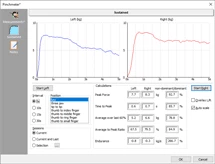
This test measures force over time for a 5, 10, 15 or 30 sec interval. Peak force, time to reach peak force, average to peak ratio percentage (sustainability) and fatigue rate are automatically calculated and immediately displayed. The current graph can be compared with a prior test to analyze progress.
Progress Reports (3/3)

Progress Reports can be easily generated covering a maximum of 10 tests and the data is displayed in both graph and table format. Automatic calculations show the percentage of change from one session to another and the percentage of change from the first test. These Reports are ideal as an immediate clinical Outcome Measure and for Discharge Summaries.
E-LINK Goniometers
E-LINK Goniometers are precise electronic devices, designed for speed and accuracy of data collection. They are invaluable for busy hand clinics and for individual patients in need of a speedy assessment to minimize discomfort from pain associated with lengthy evaluations.
The goniometer is simply placed over a joint and at the single click of a button the data is taken in 1 degree increments and entered automatically into the software. This data is clearly displayed on the hand graphic.
The software can also be configured to accommodate the neutral zero method of measurement. Progress reports can be easily generated by the software covering a maximum of 10 tests and displayed in both graphs and tables.
The small Goniometer is used for the hand to measure ROM for finger and thumb:
The large Goniometer is used for the wrist, elbow and shoulder as applicable:
Amputation, ankylosis and arthrodesis can also be documented for the above joints.

